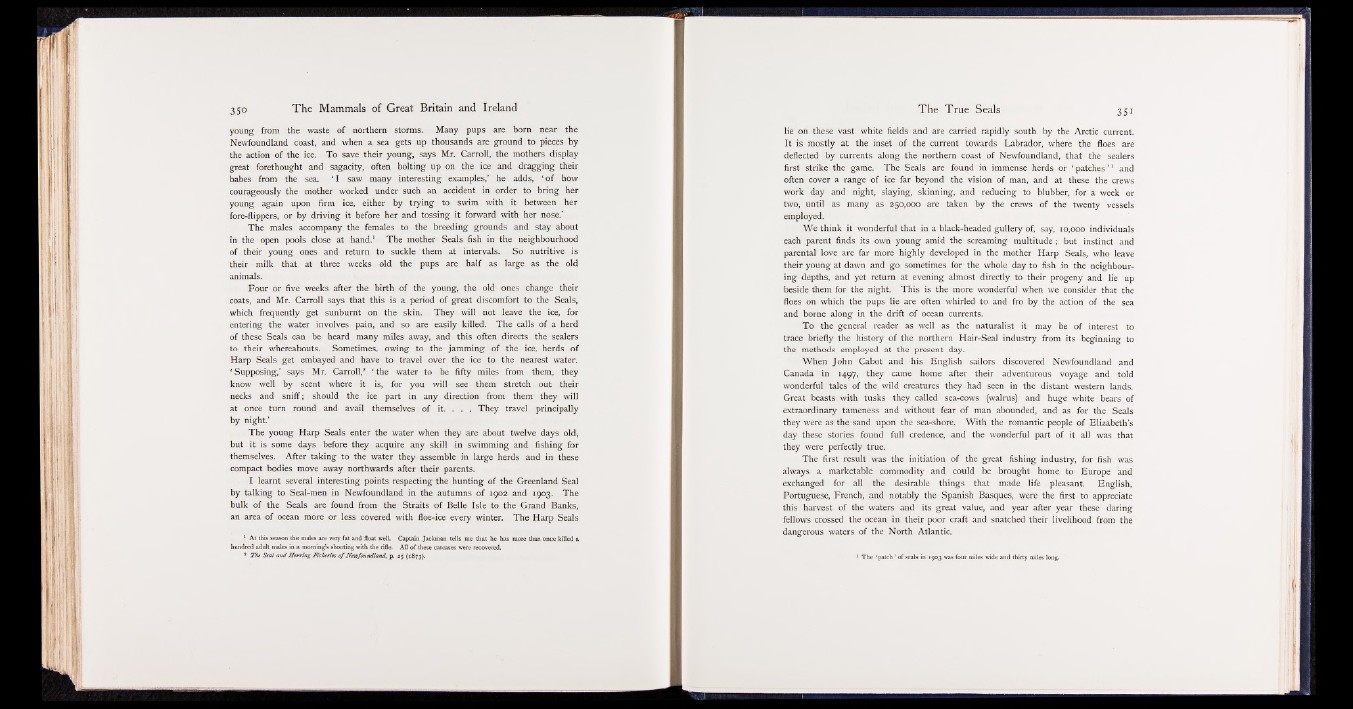
young from the waste of northern storms. Many pups are born near the
Newfoundland coast, and when a sea gets up thousands are ground to pieces by
the action of the ice. To save their young, says Mr. Carroll, the mothers display
great forethought and sagacity, often bolting up on the ice and dragging their
babes from the sea. ‘ I saw many interesting examples,’ he adds, ‘ of how
courageously the mother worked under such an accident in order to bring her
young again upon firm ice, either by trying to swim with it between her
fore-flippers, or by driving it before her and tossing it forward with her nose.’
The males accompany the females to the breeding grounds and stay about
in the open pools close at hand.1 The mother Seals fish in the neighbourhood
of their young ones and return to suckle them at intervals. So nutritive is
their milk that at three weeks old the pups are half as large as the old
animals.
Four or five weeks after the birth of the young, the old ones change their
coats, and Mr. Carroll says that this is a period of great discomfort to the Seals,
which frequently get sunburnt on the skin. They will not leave the ice, for
entering the water involves pain, and so are easily killed. The calls of a herd
of these Seals can be heard many miles away, and this often directs the sealers
to their whereabouts. Sometimes, owing to the jamming of the ice, herds of
Harp Seals get embayed and have to travel over the ice to the nearest water.
* Supposing,’ says Mr. Carroll,2 ‘ the water to be fifty miles from them, they
know well by scent where it is, for you will see them stretch out their
necks and sniff; should the ice part in any direction from them they will
at once turn round and avail themselves of it. . . . They travel principally
by night.’
The young Harp Seals enter the water when they are about twelve days old,
but it is some days before they acquire any skill in swimming and fishing for
themselves. After taking to the water they assemble in large herds and in these
compact bodies move away northwards after their parents.
I learnt several interesting points respecting the hunting of the Greenland Seal
by talking to Seal-men in Newfoundland in the autumns of 1902 and 1903. The
bulk of the Seals are found from the Straits of Belle Isle to the Grand Banks,
an area of ocean more or less covered with floe-ice every winter. The Harp Seals
1 At this season the males are very fat and float velL Captain Jackman tells me that he has more than once killed a
hundred adult males in a morning’s shooting with the rifle. All of these carcases were recovered.
* The Seal and Herring Fisheries of Newfoundland, p. 25 (1873).
lie on these vast white fields and are carried rapidly south by the Arctic current.
It is mostly at the inset of the current towards Labrador, where the floes are
deflected by currents along the northern coast of Newfoundland, that the sealers
first strike the game. The Seals are found in immense herds or ‘ patches ’ 1 and
often cover a range of ice far beyond the vision of man, and at these the crews
work day and night, slaying, skinning, and reducing to blubber, for a week or
two, until as many as 250,000 are taken by the crews of the twenty vessels
employed.
We think it wonderful that in a black-headed gullery of, say, 10,000 individuals
each parent finds its own young amid the screaming multitude; but instinct and
parental love are far more highly developed in the mother Harp Seals, who leave
their young at dawn and go sometimes for the whole day to fish in the neighbouring
depths, and yet return at evening almost directly to their progeny and lie up
beside them for the night. This is the more wonderful when we consider that the
floes on which the pups lie are often whirled to and fro by the action of the sea
and borne along in the drift of ocean currents.
To the general reader as well as the naturalist it may be of interest to
trace briefly the history of the northern Hair-Seal industry from its beginning to
the methods employed at the present day.
When John Cabot and his English sailors discovered Newfoundland and
Canada in 1497, they came home after their adventurous voyage and told
wonderful tales of the wild creatures they had seen in the distant western lands.
Great beasts with tusks they called sea-cows (walrus) and huge white bears of
extraordinary tameness and without fear of man abounded, and as for the Seals
they were as the sand upon the sea-shore. With the romantic people of Elizabeth’s
day these stories found full credence, and the wonderful part of it all was that
they were perfectly true.
The first result was the initiation of the great fishing industry, for fish was
always a marketable commodity and could be brought home to Europe and
exchanged for all the desirable things that made life pleasant. English,
Portuguese, French, and notably the Spanish Basques, were the first to appreciate
this harvest of the waters and its great value, and year after year these daring
fellows crossed the ocean in their poor craft and snatched their livelihood from the
dangerous waters of the North Atlantic.
The ‘ patch ’ o f seals in 1903 was four miles wide and thirty miles long.